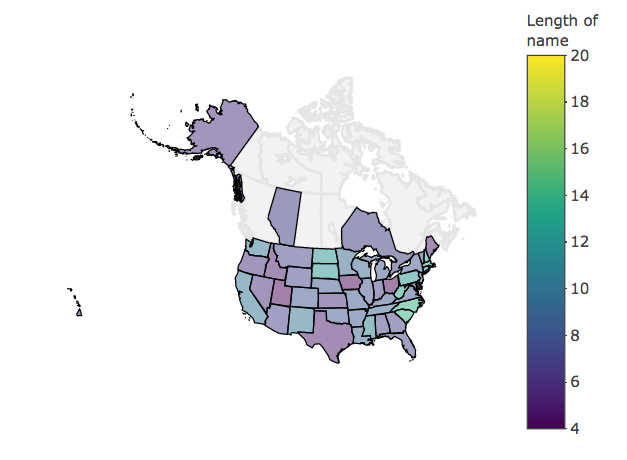Dear all, I'm building a simple app for showing some results me and my research group obtained in the past few months. Data are from specific states of USA and provinces of Canada. I'd like to incorporate data from Alberta and Ontario provinces within the North America map but, when dealing with locationmode = in plot_geo function, I'm not able to combine them with the data from the USA states. Here are attached the developed app and an example of the data we have.
library(shiny)
library(DT)
library(ggplot2)
library(plotly)
data<-read.csv(file="data.csv",header=TRUE,sep=";")
head(data)
data$results <- with(data,paste("% of subjects",'<br>', "State:",data$States_Extended,
'<br>', "Nr. of Samples:", data$Samples))
numbers <- paste("State:",data$States_Extended, '<br>',
"Nr. of Samples:", data$Samples)
ui1 <- fluidPage(
titlePanel("Map of Positive Findings"),
sidebarLayout(
sidebarPanel(
selectInput("variable", "Choose a target variable",
c("variable1" = "variable1",
"variable2" = "variable2")),
radioButtons("maps", "Select type of data:",
c("Number of samples" = "samples",
"% of subjects" = "target"))),
mainPanel(
h3(textOutput("caption")),
plotlyOutput("MapPlot"),
fluidRow(
DT::dataTableOutput("datatable")
)
)
)
)
server1 <- function(input, output) {
# Compute the formula text ----
# This is in a reactive expression since it is shared by the
# output$caption and output$mpgPlot functions
formulaText <- reactive({
paste("You chose: Map of", input$variable)
})
# Return the formula text for printing as a caption ----
output$caption <- renderText({
formulaText()
})
datasetInput <- reactive({
switch(input$variable,
"variable1" = data[,c("States_Extended","variable1")],
"variable2" = data[,c("States_Extended","variable2")]
)
})
output$datatable <- DT::renderDataTable({
datasetInput()
})
# Generate a plot of the requested variable against mpg ----
# and only exclude outliers if requested
output$MapPlot <- renderPlotly({
# give state boundaries a border
l <- list(color = toRGB("white"), width = 1)
# specify some map projection/options
g <- list(
scope = 'north america',
projection = list(type = 'albers'),
showland = TRUE,
landcolor = toRGB('grey'),
showlakes = TRUE,
lakecolor = toRGB('blue'),
landcolor = toRGB("gray95"),
subunitcolor = toRGB("gray85"),
countrycolor = toRGB("gray85"),
countrywidth = 0.5,
subunitwidth = 0.5
)
maps <- switch(input$maps,
samples = plot_geo(data, locationmode = 'USA-states',
marker = list(line = l)) %>%
add_trace(
z = ~Samples, text = numbers, locations = ~States,
color = ~Samples, colors = 'Reds'
) %>%
colorbar(title = paste('Number of <br>','analysis')) %>%
layout(
title = paste('Number of samples'),
geo = g
),
target = plot_geo(data, locationmode = 'USA-states',
marker = list(line = l)) %>%
add_trace(
z = ~data[,input$variable], text = ~results, locations = ~States,
color = ~data[,input$variable], colors = 'Oranges'
) %>%
colorbar(title = paste(input$variable,'%')) %>%
layout(
title = paste('% of subjects <br>', input$variable),
geo = g
)
)
})
}
# Run the application
shinyApp(ui = ui1, server = server1)
And the related data:
States;States_Extended;Samples;variable1;variable2
AK;Alaska;1;0;0
AL;Alabama;2;50;0
AR;Arkansas;0;;
AZ;Arizona;14;64;0
CA;California;4;0;0
CO;Colorado;2;50;0
CT;Connecticut;1;100;0
DE;Delaware;2;50;0
FL;Florida;3;100;0
GA;Georgia;7;57;29
HI;Hawaii;0;;
IA;Iowa;2;50;0
ID;Idaho;0;;
IL;Illinois;0;;
IN;Indiana;6;100;17
KS;Kansas;0;;
KY;Kentucky;12;33;17
LA;Louisiana;2;50;0
MA;Massachusetts;0;;
MD;Maryland;0;;
ME;Maine;0;;
MI;Michigan;2;100;0
MN;Minnesota;4;50;0
MO;Missouri;4;50;0
MS;Mississippi;1;100;0
MT;Montana;2;100;0
NC;North Carolina;5;60;20
ND;North Dakota;0;;
NE;Nebraska;2;0;0
NH;New Hampshire;0;;
NJ;New Jersey;4;75;25
NM;New Mexico;4;75;25
NV;Nevada;1;100;0
NY;New York;25;72;8
OH;Ohio;3;100;0
OK;Oklahoma;4;50;0
OR;Oregon;0;;
PA;Pennsylvania;8;63;0
RI;Rhode Island;1;100;0
SC;South Carolina;6;50;17
SD;South Dakota;0;;
TN;Tennessee;4;50;0
TX;Texas;7;57;14
UT;Utah;4;75;0
VA;Virginia;5;100;40
VT;Vermont;0;;
WA;Washington;0;;
WI;Wisconsin;1;0;0
WV;West Virginia;0;;
WY;Wyoming;0;;
AB;Alberta;3;100;0
ON;Ontario;1;100;0
I attach here also an example of the current developed app:
I'd be very grateful if somebody could attend to this matter. I used plotly but ggplot2 functions would be great, too.

